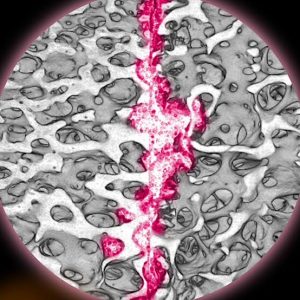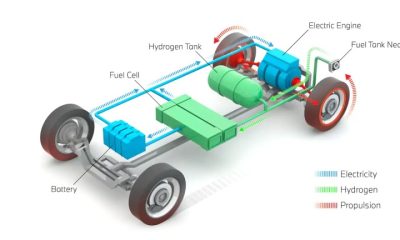Brands
RevBio Tetranite Regenerative Bone Adhesive Actions and Microgravity Technology.

Tetranite is a revolutionary biomaterial developed by the company RevBio, a Biomedical start-up that promises to transform bone repair for both patients and clinicians. Tetranite is injectable self-setting material that is highly cohesive enabling it to be placed into a wet surgical environment without being washed away during its application. The material hardens within minutes and during its curing process, forms adhesive bonds to both bone and metallic surfaces.
As a result, the material is capable of withstanding separation forces when used to adhere bone fragments together or to fixate metallic implants to bone when there is insufficient existing bone contact. Given its structural properties, RevBio is developing applications both to augment the fixation strength of existing metal implant devices and also applications for its stand-alone use with possible load-bearing applications.
Tetranite is a game changer for clinicians striving to improve outcomes across the range of human and animal bone repair applications. Currently there is no FDA approved biomaterial with the adhesive, osteo-conductive, and bioresorbable qualities that Tetranite possesses—all qualities which have been proven in existing pre-clinical animal studies. Tetranite is poised to become the first commercially available synthetic adhesive bone graft.
Tetranite Technology
Tetranite contains mineral-organic compounds modeled on natural materials. Once mixed with an aqueous medium, the material undergoes a transformation from a pliable putty to a cement-like adhesive scaffold. Once on the market, Tetranite will become the first synthetic bone adhesive. As a synthetic product, Tetranite does not rely on large molecules and therefore can be produced in large quantities at a low cost.
Mechanism of Action

Tetranite bone adhesive micro mechanism
The components in Tetranite react within minutes to yield a uniquely adhesive composite system. After hardening, Tetranite is bioengineered to withstand tensile and shear bond stresses as high as 3 MPa, similar to the strength of human cancellous bone. The Tetranite scaffold is osteoconductive and bioactive, leading to the eventual replacement of Tetranite with new bone. Over time, load bearing responsibility is transferred to the new tissue such that mechanical integrity is maintained.
How Tetranite Works
Tetranite uniquely combines two naturally occurring compounds–Tetracalcium Phosphate (TTCP) and the amino acid O-Phospho-L-Serine (OPLS) within an aqueous medium. Upon curing in situ, the biomatrial forms a multiphasic solid that is predominantly amorphous; however, several crystalline phases in lower proportion include (a) calcium-phosphoserine-monohydrate, (b) hydroxyapatite, (c) unreacted tetracalcium phosphate, and (d) unreacted α-tricalcium phosphate. Once on the market, it will become the first synthetic bone adhesive. As a synthetic product, Tetranite does not rely on large molecules and therefore can be produced in large quantities at a low cost.
Tetranite supports the body’s natural healing and bone regeneration process by providing a structure into which bone can infiltrate. Given the highly amorphous structure, which is dominated by ionic and coordination bonds, loss of ions from the cured substance is mediated by gradual dissolution as interstitial fluid contacts and penetrates the surface of Tetranite, leaving channels for bony ingrowth. New bone deposition (a reparative process naturally programmed into the connective tissue cells) is supported by neovascularization that develops in the Tetranite porosities and zones where the amorphous phase of the material has dissolved away. This is a continuous process that lasts for months until most of the Tetranite material is progressively resorbed and replaced by new bone during the healing process. The final removal of the residual crystallites of the most stable phase, hydroxyapatite, is carried out by multinucleated giant cells, the normal agents involved in the turnover of mineralized tissue.
Tetranite Microgravity Research
Tetranite is returning to space aboard SpaceX CRS-26. Previous experiments showed Tetranite can mend bones in orbit, now it will try to regenerate them. The compound first flew in 2019 after winning Boeing’s Tech in Space sponsorship.
More than 200 million people worldwide are affected by osteoporosis, a bone disease which causes bones to weaken and become increasingly susceptible to fracture. Researchers from RevBio, a biomedical startup, are turning to the microgravity environment of the International Space Station (ISS) National Laboratory to further the development of a novel therapeutic that could help repair bone fractures.
Osteoporotic fractures greatly reduce quality of life, and immobilization following a fracture can lead to further bone loss, which puts patients at risk for breaking another bone. To help patients recover quicker, RevBio developed a potential new therapeutic device, a patented bone adhesive called Tetranite, that promotes bone growth.
RevBio’s Tetranite Novel Bone Adhesive to Fly on SpaceX CRS-26
In an investigation launching on SpaceX’s 26th Commercial Resupply Services mission (SpaceX CRS-26), the company will examine how well Tetranite works to regenerate new bone during spaceflight.
“Our adhesive could not only help strengthen bones by repairing fractures but also help regenerate bone that’s very low quality or deficient in volume,” said RevBio founder and CEO Brian Hess. Improving Patient Care on Earth and for Astronauts
Microgravity has been shown to cause bone loss similar to that in patients with osteoporosis on Earth but at an accelerated rate. Previous research has also shown that microgravity blocks the development of stem cells into new cells, which the RevBio team proposes could be why astronauts lose bone mass during spaceflight. This makes the ISS an ideal environment to study osteoporosis and test therapeutics. Results from the team’s experiment could not only improve patient care here on Earth but also provide more effective health care options for astronauts on long-duration missions.
This investigation builds on prior ISS National Lab-sponsored research from RevBio (previously LaunchPad Medical). The company was awarded a grant for its initial project through the Technology in Space Prize, funded by Boeing and the Center for the Advancement of Science in Space, Inc. (CASIS), manager of the ISS National Lab, in partnership with the Mass Challenge startup accelerator program.
About the Investigation on SpaceX CRS-26
The investigation launching on SpaceX CRS-26, supported by ISS National Lab Implementation Partner Leidos Innovations Corporation, will work in two ways. First, it will investigate how skeletal stem cells (bone-specific postnatal stem cells) are affected by microgravity. And second, it will evaluate the Tetranite bone adhesive to see how it promotes bone regeneration by stimulating the skeletal stem cells.
“With this study, we will really be able to map what happens with skeletal stem cells in space compared to what happens on Earth,” said Giuseppe Intini, an associate professor at the University of Pittsburgh School of Dental Medicine and Principal Investigator of this project, who is working with the RevBio team to advance the development of the Tetranite. “That’s important because previous research indicates that microgravity may lock stem cells into an undifferentiated status, which could be what’s causing the decline of bone mass in astronauts.”
Intini says results from this experiment could help researchers better understand how to harness skeletal stem cells for therapeutic uses, which could ultimately lead to better treatments for bone fractures and methods to help mitigate the development of bone defects.
To evaluate how well Tetranite works, the team is sending 40 mice to the orbiting laboratory, some of them with a bone defect in their calvarial bone (the top part of the skull). The mice with defects are divided into three groups: those left untreated, those whose defect was filled with RevBio’s Tetranite bone adhesive compound, and those whose defect was treated with INFUSE—an inductive bone graft product from another company that is currently on the market.
“Microgravity is the ultimate test bed,” said Hess. “If we can show that our material could stimulate bone, in particular spurring bone regenerative cells to be more active and do their job more efficiently despite being in a compromised situation, that would be the ultimate demonstration.”
SpaceX CRS-26 was targeted for launch from Kennedy Space Center no earlier than November 21 at 4:19 p.m. EST due to unfavorable weather the launch is canceled and scheduled for next launch opportunity on Saturday November 26 at 2:20 pm ET.

-

 Brands2 years ago
Brands2 years agoBMW ix5 Hydrogen; Features, Release date, Price and specs.
-

 Brands2 years ago
Brands2 years agoBMW i7 All Electric Executive Sedan Features and Price
-

 Lifestyle2 years ago
Lifestyle2 years agoJeff Bezos; Networth, Career and lifestyle
-

 Brands2 years ago
Brands2 years agoDodge Charger Daytona SRT EV Concept; Electric muscle car specs, release date and price
-

 Brands2 years ago
Brands2 years agoHydrogen Fuel Cell Electric Vehicles FCEVs; Technology and features
-

 Brands2 years ago
Brands2 years agoSpace Launch System SLS; NASA’s Artemis Mega Rocket for Deep Space Exploration
-

 Brands2 years ago
Brands2 years agoHydrogen Fuel; Green Fuel of the future, types and production processes.
-

 Machinery2 years ago
Machinery2 years agoSmall Modular Reactors; Future of Modern Nuclear power generators
0 Comments